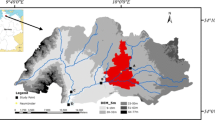Abstract
The aim of this study was to investigate the variation of channel bed roughness in two rivers, as important parameter in hydraulic modelling especially with regard to flood control. The universities of Ghent (UG) and Antwerp (UA) are conducting scientific research in the river Aa in Belgium and the Biebrza river in Poland in order to better understand the phenomena involved and to come to a more accurate determination of the different parameters influencing flow. In this paper, the determination of the roughness coefficient ‘n’ from the Manning equation is used. This coefficient is not easy to determine and is varying constantly. It is influenced by the meandering character of the river, the bed material and the average grain size, the channel bed forms, the channel obstructions, the geometry changes between sections and the vegetation in the channel. Furthermore, due to these parameters, the roughness of the channel is not equally distributed over the channel, the banks and the floodplains. So, using literature data does not always lead to satisfactory results, due to the different situation in the field (Werner et al. J Hydrol 314:139–157, 2005). Therefore, measurements are necessary to determine the variation of the Manning coefficient. The Manning coefficient is a function of the discharge, but will also vary over the time due to the mentioned influences. In a multidisciplinary research project on the fundamental exchange processes in river ecosystems, hydraulic measurements were performed on a regular base in the river Aa. During these measurement campaigns, velocity and discharge measurements were carried out in multiple cross-sections. Once a month, the discharge and the water levels were measured at the upstream and the downstream end of the test stretch. On the river Biebrza, similar intensive measurement campaigns took place along a 6 km stretch in the upstream part of the river. An accurate determination of the Manning coefficient according a seasonal variation is an important tool in hydraulic modelling.
Similar content being viewed by others
References
Aminal (2004) De Kleine Nete, computer modelling as a method, high water control as a target (in Dutch) - computermodellering als methode, hoogwaterbeheer als doel. Grontmij Belgroma nv, in order of Aminal
Anderson B, Rutherford I, Western A (2006) An analysis of the influence of riparian vegetation on the propagation of flood waves. Environ Model Softw 21: 1290–1296
Barnes H (1967) Roughness characteristics of natural channels. Technical report, USGS Water Supply Paper
Chow VT (1959) Open channel hydraulics. McGrawHill, New York
Chow VT, Maidment DR, Mays LW (1988) Applied hydrology. McGrawHill, New York
Cowan W (1956) Estimating hydraulic roughness coefficients. Agric Eng 37(7): 473–475
De Doncker L, Troch P, Verhoeven R, Bal K, Meire P (2006) Influence of aquatic plants on the flow resistance and the hydraulic capacity of vegetated rivers. In: River Flow ’06, Number ISBN 0-415-40815-6, Portugal, Lisboa, September, pp 593–602
De Doncker L, Troch P, Verhoeven R, Bal K, Desmet N, Meire P (2009) Relation between resistance characteristics due to aquatic weed growth and the hydraulic capacity of the river Aa. River Res App. doi:10.1002/rra.1240
De Doncker L, Troch P, Verhoeven R, Buis K, Desmet N, Meire P (2009) Importance of Manning’s coefficient for the calibration of the coupled Strive model. River Res Appl (in review)
De Doncker L, Troch P, Verhoeven R, Desmet N, Buis K, Meire P (2007) Stromingsweerstand in rivieren door de aanwezigheid van macrofyten. Water
DOV (2007) Databank ondergrond vlaanderen. dov.vlaanderen.be
Dyhouse G, Hatchett J, Benn J (2003) Floodplain modeling using Hec-Ras. Haestad Methods, USA. ISBN 0-9714141-0-6
Green J (2005) Effect of macrophyte spatial variability on channel resistance. Adv Water Resour 65: 232–243
Herschy R (1978) Hydrometry: principles and practices. Wiley Interscience Publication, Chichester, ISBN 0471996491
Hicks D, Mason P (1998) Roughness characteristics of New Zealand Rivers. Water Resources Publications, LLC, USA. ISBN 0-477-02608-7
Hydrologic Engineering Center, US Army Corps of Engineers (2004) HEC-RAS river analysis system, Version 2.1.4. Hydrologic engineering center. http://www.hec.usace.army.mil
Limerinos J (1970) Determination of the manning coefficient from measured bed roughness in natural channels. Technical report, USGS Water Supply Paper 1898-B
Marshall T, Lee P (1994) An inexpensive and lightweight sampler for the rapid collection of aquatic macrophytes. J Aquat Plant Manag 32: 77–79
OTT (2007) Flow measurement. http://www.ott-hydrometry.de
Strickler A (1923) Beiträge zur frage der geschwindigkeits formel und der rauhigkeitszahlen für ströme, kanale und geschlossene leitungen (some contributions to the problems of a velocity formula and roughness coefficients for rivers, canals, and closed conduits). Technical report, Mitteilungen des Eidgenössischen Amtes für Wasserwirtschaft No 16, Bern, Switzerland (as cited in Chow 1959)
Valeport (2007) Current and open channel flow meters. http://www.valeport.co.uk
Verdonschot P (1995) Beken stromen. Leidraad voor ecologisch beekherstel. STOWA, Utrecht, p 236
Verhoeven R, Banasiak R, Swiatek D, Chormanski J, Okruszko T (2002) Surface water modeling of the Biebrza river network. In: River Flow ’04 Number ISBN 90-5809-688-2, Italy, Naples, June, pp 1057–1064
Viaene P, Vereecken H (2001) Stromingsweerstand tengevolge van waterplanten. Technical report, Flanders Hydraulics. Rapport Ministerie van de Vlaamse Gemeenschap, Departement Leefmilieu en Infrastructuur, Administratie Milieu, Land-en Waterbeheer, Afdeling Water, Model 566
Watson D (1987) Hydraulic effects of aquatic weeds in UK rivers. Regul Rivers Res Manag 1: 211–227
Werner M, Hunter N, Bates P (2005) Identifiability of distributed floodplain roughness values in flood extent estimation. J Hydrol 314: 139–157
Zurek S (1984) Relief, geologic structure and hydrography of the Biebrza ice-marginal valley. Pol Ecol Stud 10(3–4): 239–251
Author information
Authors and Affiliations
Corresponding author
Rights and permissions
About this article
Cite this article
De Doncker, L., Troch, P., Verhoeven, R. et al. Determination of the Manning roughness coefficient influenced by vegetation in the river Aa and Biebrza river. Environ Fluid Mech 9, 549–567 (2009). https://doi.org/10.1007/s10652-009-9149-0
Received:
Accepted:
Published:
Issue Date:
DOI: https://doi.org/10.1007/s10652-009-9149-0




